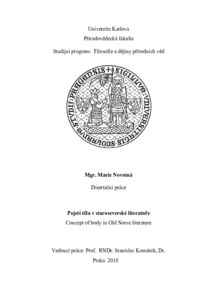Pojetí těla v staroseverské literatuře
Concept of body in Old Norse literature
dizertační práce (OBHÁJENO)

Zobrazit/
Trvalý odkaz
http://hdl.handle.net/20.500.11956/103430Identifikátory
SIS: 144900
Kolekce
- Kvalifikační práce [19614]
Autor
Vedoucí práce
Oponent práce
Horáček, Ivan
Starý, Jiří
Fakulta / součást
Přírodovědecká fakulta
Obor
-
Katedra / ústav / klinika
Katedra filosofie a dějin přírodních věd
Datum obhajoby
11. 9. 2018
Nakladatel
Univerzita Karlova, Přírodovědecká fakultaJazyk
Čeština
Známka
Prospěl/a
Klíčová slova (česky)
Old Norse literature, body, soul, dualismKlíčová slova (anglicky)
staroseverská literatura, tělo, duše, dualismusTato práce se snaží nastínit prostor představ o těle, který se ukazuje v staroseverské literatuře. Protože slovo pro tělo (líkamr) přichází stejně jako termín pro netělesnou duši (sál) do staroseverské literatury až s křesťanskou literaturou a nelze je tedy jako marker použít, jsou vybrána dvě témata, jež se představ o těle úzce dotýkají: proměna podoby (hamr) a somatické projevy emocí. V oblasti jevů spojených se změnou podoby je analyzováno sématické pole kořene ham-, a to rozborem kontextu všech nalezených výskytů tohoto kořene v staroseverské literatuře (113). V rámci tematických okruhů, které se v materiálu ukázaly (tj. změna podoby související s letem, s bojovou extází a s magií) jsou pak jednotlivé výskyty tříděny na ose od těch, kde je podoba myšlena holisticky, po ty, kdy je rozlišena na podobu těla či duše. V této souvislosti je poukázáno na blízkost člověka a zvířete v germánském prostředí, neboť proměny často se zvířecí podobou souvisejí a poukazují tak na hranice lidské identity. Také v oblasti somatických projevů emocí lze najít případy, kdy se mentální a fyzická oblast prolínají a kde hranice mezi nemocemi s emocemi není zřetelná, i ty, kde jsou obě oblasti již více či méně odděleny. Staroseverské prameny tak ukazují svou vysoce heterogenní povahu a v otázce propojení těla a duše v...
This work attempts to outline concepts associated with body in the Old Norse literature. As the word for the body (líkamr) as well as the term for an incorporeal soul (sál) do not occur in the Old Norse literature until the translated Christian works and cannot therefore be used as markers, two areas closely connected with the concept of body have been chosen for the research: shifting of shape (hamr) and somatic expressions of emotions. In the first area, i.e. phenomena associated with shape-shifting, contexts of all (113) occurrences of radix ham- in the Old Norse literature are analysed in order to describe the semantical field of this root. Within the themes that have appeared in the material (i.e. shape-shifting related to flying, battle frenzy and magic), occurrences are ordered on an axis from those where the form (hamr) is considered to be holistic to those where just the form of body or soul is described. In this context, it is important to mention the proximity of man and animal in the Germanic environment, as shape-shifting is often related to an animal and thus points to the limits of human identity. In the second area, i.e. somatic expressions of emotions, we can also find cases where the mental and the physical area intersect and the boundaries between diseases and emotions are not...
